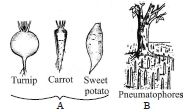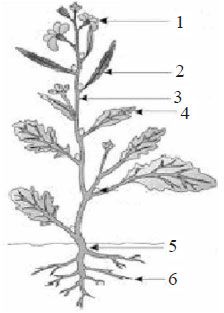Most prominent function of inflorescence is
dispersal of seeds.
formation of more fruits.
formation of pollen grains.
dispersal of pollens.
Correct Answer :
B. formation of more fruits.
The arrangements of flowers on the floral axis (peduncle) are called as inflorescence. Most prominent function of the inflorescence is the formation of more flowers.
Related Questions
Which of the following statement(s) is/are correct about calyx?
Calyx is the outermost whorl of the flower and are called sepals.
Sepals are green, leaf like and protect the flower in the bud stage.
The calyx may be gamosepalous (sepals free) or polysepalous (sepals united).
Both (a) and (b)
X is the outermost whorl of the flower and contains Y. Y is green, leaf like and protect the other whorls of the flower. Identify X and Y.
X - Calyx; Y - Sepals
X - Corolla; Y - Petals
X - Gynoecium; Y - Fruit
X - Androecium; Y - Ovary
The given figures (A & B) show two types of compound leaves. Choose the option which identity the correct compound leaf and their example (c).

A - Pinnately compound leaf, C - Neem
A - Palmately compound leaf, C - Neem
B- Pinnately compound leaf, C - Silk cotton
B- Palmately compound leaf, C - Silk cotton
The given figure shows a typical structure of monocotyledonous seeds. Identify A, B, C, D and E parts marked in the given figures.

A - Endosperm, B - Embryo, C - Scutellum, D - Coleorhiza, E - Coleoptile
A- Embryo, B - Endosperm, C - Scutellum, D - Coleoptile, E - Coleorhiza
A - Endosperm, B - Embryo, C - Scutellum, D - Coleoptile, E - Coleorhiza
A - Embryo, B - Endosperm, C - Scutellum, D - Coleorhiza, E - Coleoptile
The given figures (A and B) shows the modificaiton of roots.Which of the following statements regarding the figures is correct ?

Tap roots of carrot, turnip and adventitious root of sweet potato, get swollen and store food.
Pneumatophores conducts water, minerals & photosynthesis
Pneumatophore is found in the plants that grow in sandy soil.
Turnip & carrot shows adventitious roots and sweet potato shows tap root.
Consider the following statements regarding the root system of angiosperms and choose the correct option given below.
- In monocots, the fibrous root system arises from the base of the stem.
- The region of elongation is called the root hair region.
- In sweet potato, the adventitious roots get swollen and store food.
- The stems of maize and sugarcane have supporting roots called prop roots.
(i) and (ii) are correct but (iii) and (iv) are wrong.
(ii) and (iii) are correct but (i) and (iv) are wrong.
(ii) and (iv) are correct but (i) and (iii) are wrong.
(i) and (iii) are correct but (ii) and (iv) are wrong.
The X is small and situated in a groove at one end of the endosperm. It consists of one large and shield shaped cotyledon known as Y and a short axis with a plumule and a Z. Identify X, Y and Z.
X - Scutellum, Y - Embryo, Z - Radicle
X - Embryo, Y - Scutellum, Z - Radicle
X - Scutellum, Y - Radicle, Z - Embryo
X - Radicle, Y - Embryo, Z - Scutellum
The given figure (A, B, and C) shows different types of roots. Identify the root which is seen in wheat plant and originate from the base of the stem?

A
B
C
Both A and B
In which of the following plants, a slender lateral branch arises from the base of the main axis and after growing aerially arch downwards to touch the ground?
Mint and jasmine
Banana and pineapple
Grass and stawberry
Pistia and Eichhornia
Which of the following is correct with reference to floral character of family solanaceae?
Racemose, zygomorphic, unisexual, floral characters
Racemose, zygomorphic, bisexual, polypetalous
Axillary, bisexual, actinomorphic, epipetalous
Axillary, actinomorphic, bisexual, epipetalous
Study the following statements and select the correct option
- Buds are present in axil of leaflets of the compound leaf.
- Pulvinus leaf-base is present in some leguminous plants.
- In Alstonia, the petioles expand, become green and synthesize food.
- Opposite phyllotaxy is seen in guava.
(ii) and (iv) are correct but (i) and (iii) are incorrect.
(i) and (iii) are correct but (ii) and (iv) are incorrect.
(i) and (iv) are correct but (ii) and (iii) are incorrect.
(ii), (iii) and (iv) are correct but (i) is incorrect.
Which of the following statement(s) is/are correct about the fruit?
- Fruit is a mature or ripened ovary, developed before fertilization.
- It consists of a wall or pericarp and seeds.
- When pericarp is thick and fleshy, it is differentiated into outer mesocarp, middle epicarp and the inner endocarp.
- In mango and coconut, the fruit is known as a berry.
Only (i)
Both (ii) and (iii)
Only (ii)
All of these
During the post-fertilization period, the ovules develops into ___A____ and the ovary matures into a ___B ____.
A - seeds; B - fruit
A - fruit; B - seeds
A - flower; B - seed
A - seeds; B - flower
Identify the kind of phyllotaxy shown in the given figures A, B, and C.

A-Alternate, B - Opposite, C - Whorled
A- Whorled, B - Opposite, C -Alternate
A-Alternate, B - Whorled, C - Opposite
A-Whorled, B -Alternate, C - Opposite
The region of the root-tip which is involved in the formation of root hairs by epidermal cells is called the
region of maturation.
region of meristematic activity.
region of elongation.
none of the above.
Which of the following is not the characteristic features of fabaceae?
Tap root system, compound leaves and raceme inflorescence.
Flowers actinomorphic, twisted aestivation and gamopetalous.
Stamens 10, introrse, basifixed, dithecous.
Monocarpellary, ovary superior and bent stigma.
Which type of function is performed by the fleshy leaves of onion and garlic?
Storage
Reproduction
Photosynthesis
Protection
The given figure shows the parts of flowering plant. Which parts of the given figure were involved in the following functions:
- Storing reserve food material
- Synthesis of plant growth regulators.
- Absorption of water and minerals from the soil.
- Providing a proper anchorage to the plant parts

5 and 6
1, 2 and 6
1, 2, 3 and 4
2, 4, 5 and 6
Rearrange the following zones seen in the regions of root tip and choose the correct option.
(A) Root hair zone
(B) Zone of meristems
(C) Root cap zone
(D) Zone of maturation
(E) Zone of elongation
C, B, E, A, D
A, B, C, D, E
D, E, A, C, B
E, D, C, B, A
Prop roots of banyan tree are meant for
respiration.
absorption of water from soil.
providing support to big tree.
all of the above.
A - Which one of the option shows the correct labelling of the parts marked as A, B, C and D in a typical structure of dicotyledonous seeds ?

A - Hilum, B - Micropyle, C - Radicle, D - Cotyledon, E - Plumule
A - Hilum, B - Micropyle, C - Plumule, D - Cotyledon, E - Radicle
A - Micropyle, B - Hilum, C - Plumule, D - Cotyledon, E - Radicle
A - Hilum, B - Micropyle, C - Plumule, D - Radicle, E - Cotyledon
Leaves of dicotyledonous plants possess _________ venation, while _________ venation is the characteristic of most monocotyledons.
reticulate and parallel
parallel and reticulate
reticulate and perpendicular
obliquely and parallel
Which of the following statement(s) is/are correct about venation?
(i) The arrangement of veins and the veinlets in the lamina of leaf is called venation.
(ii) Reticulate venation is the characteristic of monocots.
(iii) When the veinlets form a network, the venation is termed as reticulate venation.
(iv) When the veins run parallel to each other, within a lamina, the venation is termed as parallel venation.
Only (i)
Both (i) and (ii)
(i), (iii) and (iv)
All of these
Matching colmun I with column II and choose the correct option.
| Column I | Column II |
|---|---|
| A. Coleorhiza | I. Grapes |
| B. Food storing tissue | II. Mango |
| C. Parthenocarpic fruit | III. Maize |
| D. Single seeded fruit | IV. Radicle developing from monocarpellary superior ovary |
| E. Membranous | V. Endosperm seed coat |
A III, B I, C IV, D II, E V
A IV, B II, C V, D I, E III
A V, B I, C III, D IV, E II
A IV, B V, C I, D II, E III
Read the following statements and answer the question.
- It is the pattern of arrangement of leaves on the stem or branch.
- It is usually of three types - alternate, opposite and whorled.
- It is meant for getting maximum amount of light. statements?
Phyllotaxy
Venation
Inflorescencew
Aestivation
Match the following stem modifications given in column I with their examples given in column II and select the correct combination from the options given below.
| (Stem Modifications) | (Found in) |
|---|---|
| A. Underground stem | I. Euphorbia |
| B. Stem tendril | II. Opuntia |
| C. Stem thorns | III. Potato |
| D. Flattened stem | IV. Citrus |
| E. Fleshy cylindrical stem | V. Cucumber |
A I, B II, C III, D V, E IV
A II, B III, C IV, D V, E I
A III, B IV, C V, D I, E II
A III, B V, C IV, D II, E I
Which of the following statement(s) is /are correct?
- Many plants belong to family fabaceae are good ornamentals (Tulip, Gloriosa), source of medicine (Aloe) and vegetables (Asparagus).
- The plumule and radicle are enclosed in sheaths which are called coleorhiza and coleoptile respectively.
- A flower having either only stamens or only carpels is unisexual.
- Basal, alternate, linear, exstipulate with parallel venation types of leaves is found in the family liliaceae.
Only (i)
Both (i) and (ii)
Both (iii) and (iv)
All of these
Which of the following option shows the correct labelling of the parts of leaf marked as A, B, C and D.

A - Lamina, B - Axillary bud, C - Stipule, D - Leaf base
A - Lamina, B - Stipule, C - Axillary bud, D - Leaf base
A - Lamina, B - Axillary bud, C - Stipule, D - Pedicel
A - Leaflet, B - Axillary bud, C - Stipule, D - Leaf base
Match column-I with column-II and choose the correct option.
| A. Gram, sem, moong, | I. Medicine soyabean |
|---|---|
| B. Soyabean,groundnut | II. Ornamental |
| C. Indigofera | III. Fodder |
| D. Sunhemp | IV. Fibres |
| E. Sesbania, Trifolium | V. Dye |
| F. Lupin, sweet potato | VI. Edible oil |
| G. Mulethi | VII. Pulses |
A I, B II, C III, D IV, E V, F VI, G VII
A VII, B VI, C V, D IV, E III, F II, G I
A II, B IV, C VI, D I, E III, F V, G VII
A I, B III, C V, D VII, E II, F IV, G VI
Cotyledons and testa respectively are edible parts in which of the following group?
walnut and tamarind
cashew nut and litchi
french bean and coconut
groundnut and pomegranate
